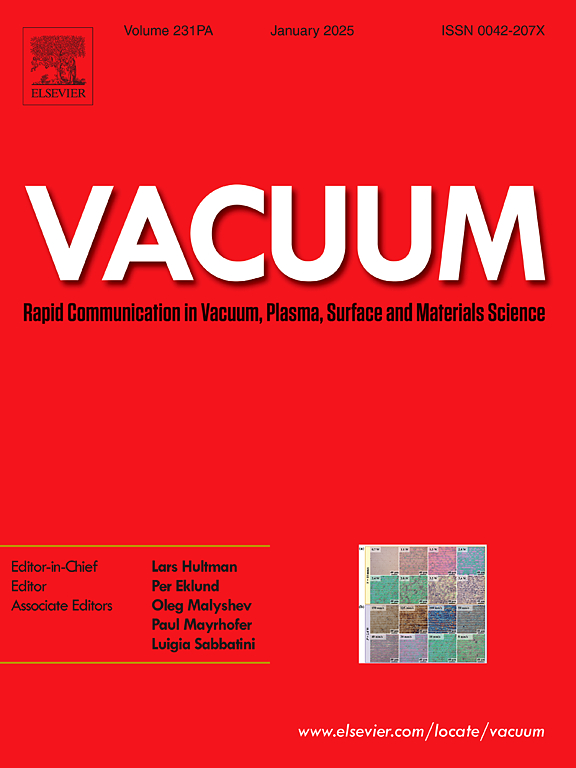二次电子发射功能层微通道板关键参数对器件增益的演化影响
IF 3.9
2区 材料科学
Q2 MATERIALS SCIENCE, MULTIDISCIPLINARY
引用次数: 0
摘要
本文对影响微通道板(MCP)增益的关键参数进行了研究。通过在MCP内壁沉积Al2O3和MgO纳米膜,在1500 V偏置电压下,器件增益从104增加到105以上。仿真结果表明,微通道内壁的二次电子发射(SEE)、偏置电压和MCP结构参数对MCP增益有很大影响。具体来说,当SEE产率峰值(δm)从3增加到4时,MCP增益提高了两个数量级以上。另外,当SEE功能层厚度从1 nm增加到5 nm时,δm从2.6增加到3.8,导致MCP增益从3 × 103增加到5 × 105。仿真还表明,每增加100 V的偏置电压,MCP的增益就增加2.3倍。此外,微通道宽高比通过影响微通道内电子碰撞次数来影响MCP增益,仿真结果表明,当宽高比从22增加到42时,在1000 V偏置电压下,MCP增益从1.5 × 102增加到4 × 105。详细讨论了影响MCP增益的关键参数,对提高MCP性能具有重要的工程意义。本文章由计算机程序翻译,如有差异,请以英文原文为准。
Evolution impact of key parameters on device gain for the microchannel plates with secondary electron emission functional layer
In this work, we conduct a research on key parameters affecting microchannel plate (MCP) gain. By depositing Al2O3 and MgO nanofilms on the MCP inner walls, the device gain increases from 104 to over 105 at 1500 V bias voltage. Simulations demonstrate that secondary electron emission (SEE) of the microchannel inner wall, bias voltage, and MCP architecture parameters can substantially affects MCP gain. Specifically, as the SEE yield peak value (δm) grows from 3 to 4, the MCP gain improves by over two orders of magnitude. Additionally, when the SEE functional layer thickness increases from 1 nm to 5 nm, δm climbs from 2.6 to 3.8, leading to an increase of MCP gain from 3 × 103 to 5 × 105. Simulation also indicates the MCP gain rises 2.3 times with every 100 V increase in bias voltage. Besides, the microchannel aspect ratio influences the MCP gain by affecting the electron collision times inside the microchannels, with simulations showing the MCP gain rises from 1.5 × 102 to 4 × 105 at 1000 V bias voltage when the aspect ratio increases from 22 to 42. This work provides a detailed discussion of the key parameters influence on MCP gain, which holds engineering significance for enhancing the MCP performance.
求助全文
通过发布文献求助,成功后即可免费获取论文全文。
去求助
来源期刊

Vacuum
工程技术-材料科学:综合
CiteScore
6.80
自引率
17.50%
发文量
0
审稿时长
34 days
期刊介绍:
Vacuum is an international rapid publications journal with a focus on short communication. All papers are peer-reviewed, with the review process for short communication geared towards very fast turnaround times. The journal also published full research papers, thematic issues and selected papers from leading conferences.
A report in Vacuum should represent a major advance in an area that involves a controlled environment at pressures of one atmosphere or below.
The scope of the journal includes:
1. Vacuum; original developments in vacuum pumping and instrumentation, vacuum measurement, vacuum gas dynamics, gas-surface interactions, surface treatment for UHV applications and low outgassing, vacuum melting, sintering, and vacuum metrology. Technology and solutions for large-scale facilities (e.g., particle accelerators and fusion devices). New instrumentation ( e.g., detectors and electron microscopes).
2. Plasma science; advances in PVD, CVD, plasma-assisted CVD, ion sources, deposition processes and analysis.
3. Surface science; surface engineering, surface chemistry, surface analysis, crystal growth, ion-surface interactions and etching, nanometer-scale processing, surface modification.
4. Materials science; novel functional or structural materials. Metals, ceramics, and polymers. Experiments, simulations, and modelling for understanding structure-property relationships. Thin films and coatings. Nanostructures and ion implantation.
 求助内容:
求助内容: 应助结果提醒方式:
应助结果提醒方式:


